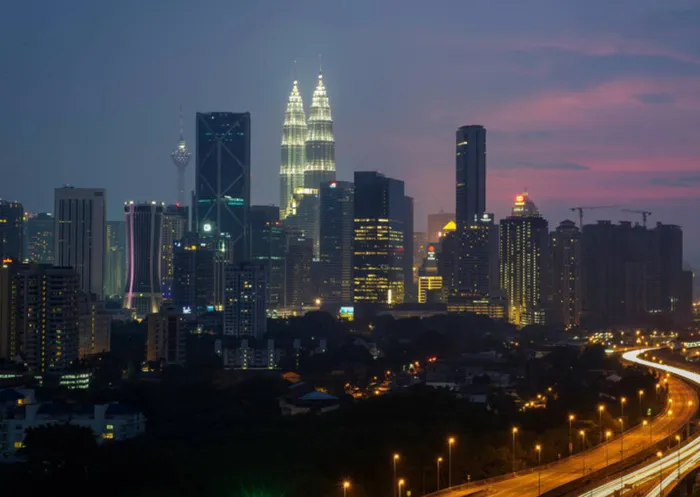Charting a path for South Africa’s economic renewal
Indonesia and Malaysia: lessons in resilience, industrialisation, and global opportunity

Malaysia's landmark Petronas Twin Towers and Kuala Lumpur Tower at dusk in Kuala Lumpur.
Image: SUPPLIED
SOUTH Africa’s economic landscape faces momentous challenges, as underscored recently by the imposition of United States tariffs on South African goods which has exposed the vulnerabilities inherent in the country’s economic structure. There is an urgent need to rethink industrial policy, diversify trade relationships, and develop robust strategies for resilience. In an era defined by shifting global centres of power and an increasingly multipolar world, South Africa must look outward, drawing inspiration from nations that have had notable successes with industrialisation strategies.
Among the most instructive examples are Indonesia and Malaysia who, over the past 30 years, have demonstrated remarkable growth, significant poverty reduction, and the emergence of robust middle classes. Their experiences offer South Africa practical, actionable insights as it seeks to overcome its own hurdles, including slow economic growth, high unemployment, deteriorating infrastructure, and persistent governance challenges.
Responding to crisis: lessons from the Asian financial Crisis of 1997–98
In the late 1990s, the Asian Financial Crisis swept across the region, testing the mettle of governments and societies alike. The crisis wreaked havoc: currencies plummeted, banking systems teetered on the edge of collapse, and millions were thrust into poverty. Indonesia’s economy contracted by over 13%, while Malaysia slipped into a deep recession, its currency battered by speculative attacks.
The recovery strategies adopted by these nations provide insightful guidance on the power of decisive and at times unconventional policy. Malaysia, braving criticism from orthodox economists, imposed controls to halt capital flight, pegged its exchange rate to the US dollar, reformed its banking sector, and deployed fiscal stimulus to protect jobs and support domestic demand. While these interventions were contentious, their effectiveness became evident as Malaysia’s economy stabilised more rapidly than many had anticipated.
Indonesia, for its part, embarked on a comprehensive programme of economic reform.
The government restructured the banking sector, liberalised key industries, rationalised SOEs and implemented reforms that laid the groundwork for future growth. These measures were often painful and politically challenging, but they underscored the necessity of adaptability, political will, and strong leadership during times of crisis.
The central lesson is that effective crisis management requires adaptability, political resolve, strong leadership and a focus on protecting jobs, supporting households and preserving productive capacity. South Africa, frequently exposed to global volatility, can draw on these examples to prepare effective responses to future shocks.
South Africa has the advantage of a robust financial system, strong regulatory frameworks, and a strategic location on global trade routes with excellent regional and international connectivity and a sophisticated business environment.
Industrial Policy and the Pursuit of export-led growth
For Indonesia and Malaysia, recovery from the crisis was only the first step. Both nations recognised that economic stabilisation had to be coupled with proactive industrial policy and a commitment to export-led growth if prosperity was to be sustainable.
Malaysia, through a series of Industrial Master Plans, methodically shifted its economy away from a reliance on primary commodities such as rubber and tin towards higher-value manufacturing. Over several decades, the government invested heavily in education and vocational training, established Special Economic Zones, and fostered an environment conducive to foreign direct investment. Today, Malaysia stands as a significant global exporter of semiconductors, electronics, and services. In 2024, Malaysia’s GDP reached US$422 billion, with GDP per capita approaching US$12,000 - a testament to the transformative power of strategic economic planning.
Indonesia adopted a different but strategic approach. The government identified the untapped potential of its natural resources and human potential and initiated a policy of “downstreaming.” Rather than exporting raw materials Indonesia promoted domestic processing and value addition. This policy shift attracted major investment in smelting, stainless steel production, and now, the burgeoning electric vehicle supply chain. The entry of SMEs into manufacturing for export was encouraged through policy and interventions. The results have been emphatic: with a GDP of US$1.4 trillion and steady annual growth of around 5%, Indonesia is now Southeast Asia’s largest economy, well-positioned to capitalise on new technologies and global supply chains.
These experiences show that modern industrialisation is less about heavy government intervention and more about guiding markets, targeting sectors with potential, and fostering an environment conducive to investment. By implementing a focused industrial strategy around mineral beneficiation, battery manufacturing, agro-processing, clothing and pharmaceuticals, South Africa can generate jobs and increase exports.
Export orientation and global value chains
Malaysia’s integration into global electronics supply chains and Indonesia’s emergence in resource-based manufacturing highlight the importance of exports.
Export-led growth brings in foreign exchange, boosts productivity, and drives innovation. South Africa’s export basket is still heavily concentrated on raw commodities. To diversify, addressing logistics bottlenecks, improving port operations, and streamlining customs processes are vital.
Building robust trading relationships with alternate trading partners is equally important. At present, South Africa’s trade with Indonesia and Malaysia is modest - less than US$3 billion combined in 2024. By comparison, these countries are major global exporters. South Africa can position itself as a strategic partner by supplying minerals, agricultural goods, and manufactured products, while importing advanced technologies and investments.
Indonesia and Malaysia also present important markets for South African beef, dairy, agricultural product and defence and mining equipment. In 2023, Indonesia approved the import of 50,000 head of cattle and 300,000 metric tonnes of soybeans from South Africa.
Investing in human capital
Both Indonesia and Malaysia made major investments in education, particularly in technical and vocational training, to ensure their workforce could meet the demands of modern industries. With youth unemployment in South Africa hovering around 45%, there is a pressing need to address the gap between education and the requirements of the job market. Revamping technical and vocational education, enhancing apprenticeships, and incentivizing companies to train and employ youth are essential steps toward a skilled workforce.
Here lies another clear lesson - without substantial investment in technical training, apprenticeships, and industry-aligned education, industrial policy cannot succeed. A workforce equipped with relevant skills is the bedrock of industrialisation.
Infrastructure and governance
Indonesia’s recent investments in infrastructure - building highways, ports, airports, energy, and a new capital city - have reduced logistics costs and attracted investment. Malaysia continues to advance its digital and energy infrastructure. By contrast, South Africa has faced ongoing challenges with electricity supply, congested ports, ageing rail networks, and security concerns. Addressing issues at Eskom, upgrading Transnet’s Rail and Port operations, and securing maintenance budgets for roads and water systems should be urgent priorities.
Sound governance, with clear rules, efficient regulations and protection from corruption, is essential for attracting investors. Indonesia and Malaysia have made strides in governance that improved their competitiveness.
Regional cooperation: BRICS and ASEAN
Indonesia’s full entry into BRICS in 202 and Malaysia’s BRICS Country Partner Status, coupled with South Africa’s partner status at ASEAN, opens doors for deeper cooperation. This creates avenues for deeper cooperation in several key areas:
1. Mineral and Downstream Processing: Joint ventures in refining and battery materials.
2. Energy Transition: Shared investment in renewables, energy storage, and infrastructure financing models.
3. Trade and Logistics: Reducing barriers, improving port coordination, and boosting two-way trade exchanges.
4. Skills Partnerships: Mutual recognition of vocational training, student exchanges, and joint training centres.
5. Digital Economy: Cooperation in fintech, data centres, e-commerce, and regulatory learning.
By leveraging historical ties and partnerships within ASEAN, BRICS, and IORA, South Africa can expand trade and attract investment from Indonesia and Malaysia.
Turning lessons into action
The experiences of Indonesia and Malaysia illustrate that development is a result of deliberate and consistent choices: investing in education, building world-class infrastructure, targeted industry support, and pragmatic crisis management. South Africa has the resources and potential to replicate this success but only if ambition is matched with practical execution and ongoing improvements in governance and service delivery.
There is no single solution. Success comes from sustained, well-implemented policies, strategic investments, and a willingness to innovate - even with unconventional tools when necessary.
South Africa has shared historic relations with both Indonesia and Malaysia and has enjoyed goodwill with both countries. Indonesia’s 283 million population and Malaysia’s 35 million population represent significant markets for South African goods and entry into the broader ASEAN 700 million consumer population. On the other hand, South Africa represents the gateway into the SADC’s 400 million consumer market.
People to people linkages are an important part of the culture in the region. More business and government visits between the countries are required to better appreciate the potentials and the opportunities. The last State visit of a South African head of State to Malaysia was in 2013 and to Indonesia in 2017. Now is an opportune time for a State led business delegation to explore opportunities and partnerships.
Final thoughts: South-South cooperation
Indonesia and Malaysia demonstrate that emerging economies can achieve enduring progress through a combination of industrial policy, export orientation, and crisis resilience. For South Africa, the path forward is clear: develop a credible plan that aligns industrial targets with visible reforms, develop the necessary skills base, leverage regional partnerships and use diplomatic channels to attract investment and technical expertise. These steps would do more that slogans can – they can create jobs and realise the economic potential.
The path to growth is not in endless debates but in learning from those who have
already walked the road. The lesson from Southeast Asia is not about copying models but about execution. Visionary roadmaps, aligned with practical reforms in governance, infrastructure, and skills, implemented with decisive leadership can change a country’s trajectory. Malaysia and Indonesia proved it. South Africa can too - if we act with urgency and focus.

Ebrahim Patel
Image: SUPPLIED
Patel is the CEO of Magellan Management. He has more than two decades of experience doing business with Indonesia and Malaysia and has built extensive relationships with the private sector and governments in the region. He is the current president of the Minara Chamber of Commerce. He writes in his personal capacity.
Related Topics: